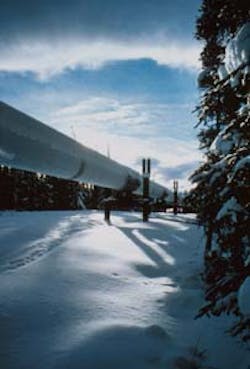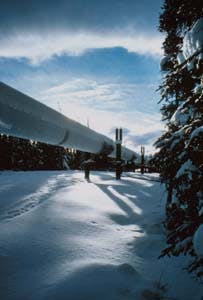TAPS' reduced flow to reflect N. Slope decline
An elevated segment of the trans-Alaska pipeline.
Alyeska Pipeline Service Co. plans to place on standby two of the 10 pump stations on the Trans-Alaska Pipeline System (TAPS) July 1 due to declining North Slope oil production.
The 800 mile pipeline has moved more than 11 billion bbl of crude since it was completed 19 years ago. At its peak, 2.1 million b/d flowed from the North Slope to a tanker terminal at Valdez.
Alyeska plans to put Pump Station 8, just south of Fairbanks, and Pump Station 10, north of Glennallen, in standby status. It can return them to full service within 6 months if necessary-even faster in case of emergency.
Pump Station 7, which is off line for maintenance and modification, will return to service before Stations 8 and 10 are idled.
Roger Staiger, Alyeska's Washington representative, said, "The company continues to look for efficient, streamlined operating changes that will keep North Slope crude oil competitive on the world market. This, in turn, will lead to a longer life for the trans-Alaska pipeline."
System throughput
TAPS originally was designed for a maximum throughput of 2 million b/d using 12 pump stations.
Although pump station numbers run from 1 to 12, Station 11 was not built. Station 5 is a pressure relief station on the south side of the Brooks Range which has no main line pumps.
Development and injection of a drag reduction additive (DRA) enabled the pipeline to exceed capacity and move more than 2.1 million b/d in 1988 using all 10 pump stations. DRA consists of long chain polymers that reduce turbulence within the oil flow and friction between the crude and pipe wall.
Under a new operating plan, Alyeska will inject DRA at Stations 7 and 9.
Baker Pipeline Products Co. makes the DRA Alyeska uses.
Current North Slope production and TAPS throughput is about 1.5 million b/d.
TAPS will have a capacity of 1.7 million b/d using eight stations. Alyeska plans to keep line capacity at 200,000 b/d more than projected North Slope production so oil output won't be constrained.
Alyeska said it may idle Stations 2 and 6 in 1997 and Station 12 in 1998 if North Slope throughput continues to decline as predicted.
TAPS is regulated by the Joint Pipeline Office (JPO), which consists of representatives of Alaska's Natural Resources and Environment Conservation departments, and the federal Bureau of Land Management, Office of Pipeline Safety, Environmental Protection Agency, and U.S. Coast Guard.
Although Alaska does not need JPO approval to close Stations 8 and 10, it does need approval to remove and transfer personnel that are part of oil spill prevention and response plans.
It will maintain the piping at the two standby stations to Transportation Department requirements. Cathodic protection on piping will remain active. Most electronic communication gear, control equipment, pumps, and heaters will remain in place. Delicate equipment and the jet engines and reaction turbine that drive the pumps will be moved. Security will be maintained at the closed stations.
Pump Stations 8 and 10 have colocated topping units that provide diesel fuel for the dual 15,300 hp pumps and motor vehicles. Station 8 stopped fuel production last May, and Station 10 will do likewise when it is closed.
Leak detection
Separately, Alyeska told JPO it will install probes to ensure there are no leaks at 40 valves along the line.
That was in response to a leak north of Glennallen that released about 20,000 gal of crude onto the ground. The leak, caused by a loose plug, was found after a worker noticed oil in a nearby manhole.
Crews have almost completed cleanup of soil at the site. No significant environmental damage occurred.
Alyeska also said it will consider expediting a 5 year program to excavate and examine the buried valves.
Copyright 1996 Oil & Gas Journal. All Rights Reserved.

